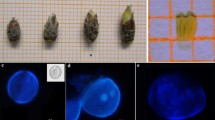Summary
Factors favouring callus proliferation and subsequent regeneration of plants from pollen grains of rice anthers (Oryza sativa L., cvx. Bahia, Girona, Balilla × Sollana and Sequial) were determined. Cultivar differences in response were found, such as a high rate of haploid plant regeneration.
In addition, isolated pollen grain culture was used to induce tissue proliferation outside the anther walls. The frequency of callus formation from isolated pollen grains was very low. It was necessary to preculture the anthers before pollen grain separation, in order to accomplish a successful development later. Root differentiation was observed in some of the obtained callus.
Similar content being viewed by others
References
Bourgin, J. P. & J. P. Nitsch, 1967. Obtention de Nicotiana haploides à partir d'étamines cultivées in vitro. Ann. Physiol. Vég. 9: 377–382.
Chen, C. C., 1976. Studies on the anther culture of rice, pollen stage and low temperature treatment. Nat. Sci. Council Monthly Taiwan. 4: 2187–2190.
Chen, C. C., 1977. In vitro development of plants from microspores of rice. In Vitro 13: 484–489.
Clapham, D., 1973. Haploid Hordeum plants from anthers in vitro. Z. Pflanzenzüchtg 69: 142–155.
Corduan, G., 1975. Regeneration of anthers derived plants of hyoscyamus niger L. Planta 127: 27–36.
Dunwell, J. M. & N. Sunderland, 1973. Anther culture of Solanum tuberosum L. Euphytica 22: 317–323.
Gresshoff, P. M. & C. H. Doy, 1972. Development and differentiation of haploid Lycopersicon esculentum (tomato). Planta 107: 161–170.
Guha, S. & S. C. Maheshwari, 1964. In vitro production of embryos from anthers of Datura. Nature 204: 497.
Guha, S. & S. C. Maheshwari, 1966. Cell division and differentiation of embryos in the pollen grains of Datura in vitro. Nature, Lond. 212: 97–98.
Guha-Mukherjee, S., 1973. Genotypic differences in the in vitro formation of embryoids from rice pollen. J. exp. Bot. 24: 139–144.
Harn, C., 1969. Studies on the anther culture of rice. Korean J. Breed. 1: 1–11.
Hsu, S. C. & C. C. Chen, 1977. Studies on the anther culture of rice: origin of the anther derived diploid plants. Nat. Sci. Council Monthly Taiwan 5: 834–839.
Institute of Genetics (401 Research Group) Academia Sinica, Peking, 1975. Primary study on induction of pollen plants of Zea mays. Acta genet. Sinic. 2: 138–143.
Iyer, R. D. & S. K. Raina, 1972. The early ontogeny of embryoids and callus from pollen and subsequent organogenesis in anther cultures of Datura metel and rice. Planta 104: 146–156.
Kameya, T. & K. Hinata, 1970. Induction of haploid plants from pollen grains of Brassica. Jap. J. Breed. 20: 82–87.
Murashige, T. & F. Skoog, 1962. A revised medium for growth and bioassays with tobacco tissue cultures. Physiologia Pl. 15: 473–497.
Niizeki, H. & K. Oono, 1968. Induction of haploid rice plants from anther culture. Proc. Jap. Acad. 44: 554–557.
Niizeki, H. & K. Oono, 1971. Rice plants obtained by anther culture. In: Les cultures de tissus de plantes. Colloques Internationaux du C.N.R.S. 193.
Nishi, T. & S. Mitsuoka, 1969. Occurrence of various ploidy plants from anther and ovary culture of rice plant. Jap. J. genet. 44: 341–346.
Nitsch, C., 1974. La culture de pollen isolé sur milieu synthétique. C.r. hebd. Séanc. Acad. Sci., Paris 278: 1031–1034.
Nitsch, C. & B. Norreel, 1973. Effect d'un choc thermique sur le pouvoir embryogène du pollen de Datura innoxia cultivé dans l'anthère ou isolé de l'anthère. C.r. hebd. Séanc. Acad. Sci., Paris 276: 303–306.
Nitsch, J. P. & C. Nitsch, 1965. Néoformation de fleurs in vitro chez une eséce de jours courts: Plumbago indica L. Ann. Physiol. Vég. 7: 251–258.
Sunderland, N. & F. M. Wicks, 1971. Embryoid formation in pollen grains of Nicotiana tabacum. J. exp. Bot. 22: 213–226.
Thomas, E., F. Hoffman & G. Wenzel, 1975. Haploid plantlets from microspores of rye. Z. Pflanzenzüchtg 75: 106–113.
Wang, C. C., C. C. Chu, C. S. Sun, S. H. Wu, K. C. Yin & C. Hsu, 1973. The androgenesis in wheat (Triticum aestivum) anthers cultured in vitro. Scientia Sinic. 16: 218–222.
Wang, C. C., C. S. Sun & Z. C. Chu, 1974. On the conditions for the induction of rice pollen plantlets and certain factors affecting the frequency of induction. Acta. Bot. Sinic. 16: 43–54.
Wenzel, G. & E. Thomas, 1974. Observations on the growth in culture of anthers of Secale cereale. Z. Pflanzenzüchtg 72: 89–94.
Author information
Authors and Affiliations
Rights and permissions
About this article
Cite this article
Cornejo-Martin, M.J., Primo-Millo, E. Anther and pollen grain culture of rice (Oryza sativa L.). Euphytica 30, 541–546 (1981). https://doi.org/10.1007/BF00038780
Received:
Issue Date:
DOI: https://doi.org/10.1007/BF00038780




